Physical Address
304 North Cardinal St.
Dorchester Center, MA 02124
Physical Address
304 North Cardinal St.
Dorchester Center, MA 02124
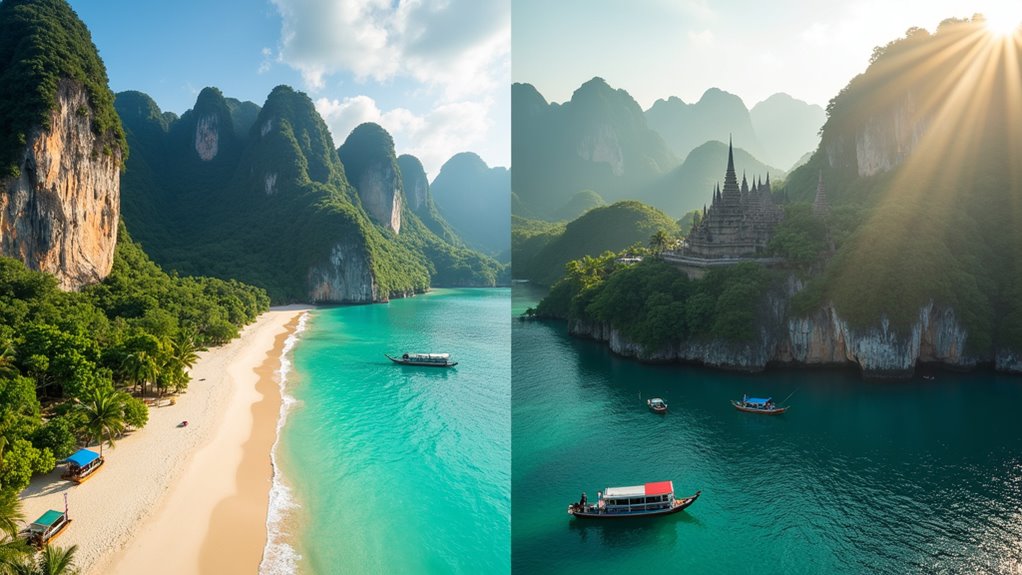
Thailand's contrasting gems offer distinct travel experiences—discover whether cultural Chiang Mai or beachy Phuket matches your ideal getaway.
Chiang Mai offers a cooler mountain setting with abundant cultural heritage, 117 temples, and markedly lower costs for accommodation, food, and transportation. Phuket delivers tropical island living with stunning beaches, vibrant nightlife, and seafood cuisine, but at nearly double the price. Visit Chiang Mai (November-February) for authentic northern Thai experiences and misty mountains, or choose Phuket’s year-round warmth and coastal adventures. Your perfect Thai destination depends on whether you crave culture or beachside relaxation.
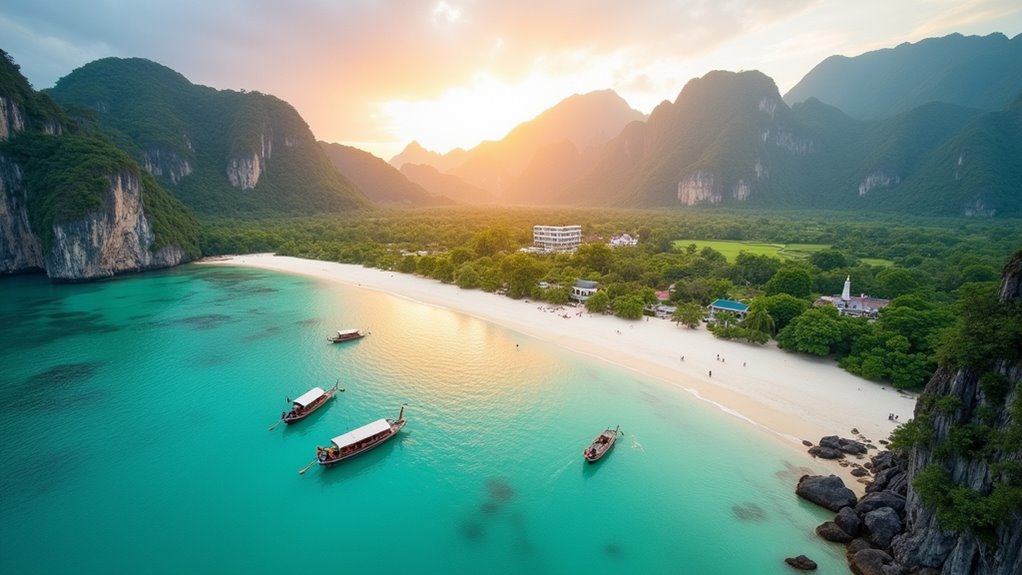
When deciding between Chiang Mai and Phuket, you’re fundamentally choosing between two dramatically different Thai experiences separated by over 1,500 kilometers.
Chiang Mai nestles in northern Thailand’s mountainous valleys at 300m elevation, surrounded by highlands and dominated by Doi Inthanon, Thailand’s highest peak at over 8,400 feet. The Ping River basin carves through this mountain city, where cool, misty winters contrast with rainy summers. Northern Thailand’s mountains extend along the Myanmar border, forming a stunning backdrop to this cultural capital.
Embrace Chiang Mai’s mountain embrace—a riverside sanctuary where misty peaks meet cultural depth at 300m above sea level.
Phuket, conversely, is Thailand’s largest island in the southern Andaman Sea, defined by its coastal geography. You’ll find white-sand beaches like Patong and Kata, lush rainforests, and distinctive limestone cliffs. The tropical climate stays hot and humid year-round, with an extended monsoon season from May through September or October. Unlike Koh Phangan with its sunset viewing spots, Phuket offers a more developed beach experience with extensive tourism infrastructure.
Your choice? Mountain tranquility or beach paradise—Thailand offers both extremes.
Choosing between Chiang Mai and Phuket becomes especially significant when examining your budget, as these destinations offer dramatically different financial experiences. The numbers tell a clear story: your money stretches significantly further in Chiang Mai.
Housing costs reveal the starkest contrast, with Chiang Mai’s city-center apartments ($300-$500 monthly) substantially cheaper than Phuket’s equivalent offerings ($450-$700). This pattern repeats across all categories—meals at local eateries cost almost twice as much in Phuket, while transportation expenses run 30-50% higher on the island. The affordability gap extends to accommodation options, with Chiang Mai offering studio condos from as little as $300 with pool and gym amenities included. While both locations cost less than Koh Samui, which is known for its premium pricing especially in tourist areas.
Even healthcare follows this trend, with basic medical visits priced 50% higher in Phuket.
For budget-conscious travelers or digital nomads, Chiang Mai delivers similar quality of life while allowing your baht to go dramatically further.
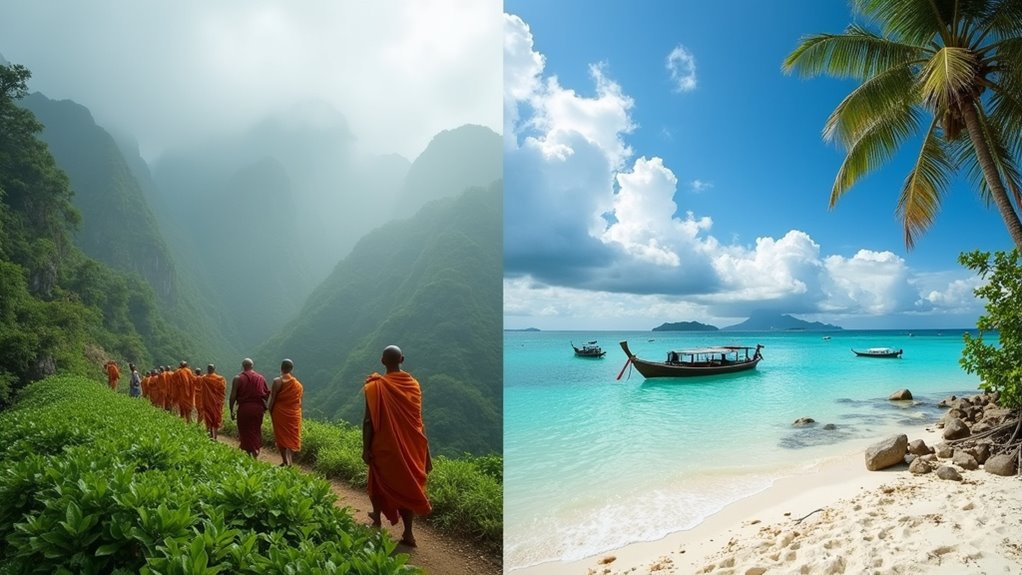
The climate differences between Chiang Mai and Phuket are as dramatic as their landscapes, creating two distinct seasonal experiences for travelers to navigate.
Phuket maintains a steady tropical climate (averaging 28°C year-round) with heavy rainfall (134mm monthly).
Chiang Mai experiences wider temperature swings (14-33°C) with considerably less precipitation. The sunshine patterns between both locations are remarkably similar, with approximately 9.4 hours daily throughout the year.
For beach lovers, Phuket shines from November to February with minimal rain and comfortable 27°C temperatures.
Chiang Mai’s prime season also falls between November and February, offering pleasant 21-29°C days with crisp mornings and cultural festivals.
Avoid both destinations during the May-October monsoon season, and steer clear of Chiang Mai in March-April when agricultural burning creates hazardous air quality.
Phuket’s coastal breezes maintain better air quality year-round despite higher humidity.
Regardless of your destination choice, understanding safety concerns in Thailand will help ensure your trip remains enjoyable and trouble-free.
Thailand’s culinary landscape divides dramatically between north and south, offering two distinct gastronomic experiences that mirror each region’s geography and cultural heritage.
In Chiang Mai, you’ll discover herb-heavy cuisine featuring lemongrass and dill in dishes like Kaeng Om (herb-packed soup) and sticky rice served alongside Naem Mok (fermented pork sausage). The northern dishes typically avoid coconut milk due to the region’s landlocked geography, relying instead on local herbs and preserved ingredients. Don’t miss Khao Soi—crispy noodles in coconut curry—and Sai Ua Moo, a spiced sausage showcasing Lanna preservation techniques. Thai cuisine is globally renowned for its perfect balance of sweet, sour, salty, and spicy flavors that create memorable taste experiences.
Phuket delivers coastal abundance with fresh-caught seafood often prepared with chili-lime marinades. The island’s Chinese-Malay fusion appears in Mee Hokkien (seafood noodles) and O-Tao (oyster omelet). Experience bold flavors in Gaeng Som (sour orange curry) and Pla Kapong Neung Manao (steamed sea bass with lime) at vibrant night markets like Banzaan.
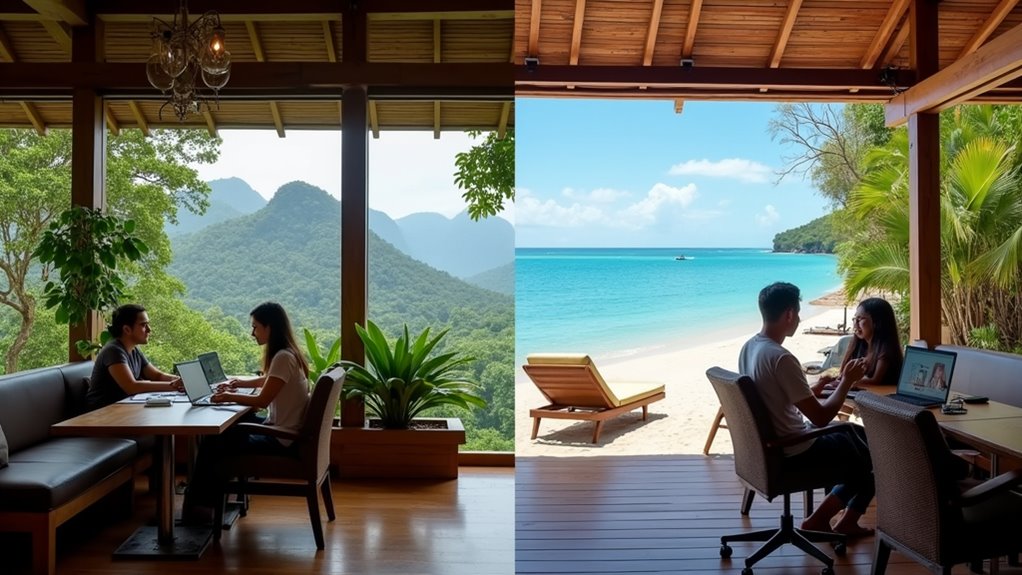
While food might nourish your body during your Thai adventures, reliable internet and workspace will sustain your digital lifestyle. Chiang Mai clearly leads in the digital nomad ecosystem, offering over 20 coworking spaces at budget-friendly prices starting around ฿429/day.
For digital nomads seeking Thailand’s embrace, Chiang Mai’s 20+ affordable workspaces form the backbone of a thriving remote community.
Chiang Mai’s established nomad community provides extensive networking opportunities and regular meetups that you won’t find as frequently in Phuket. The city’s serene atmosphere creates a productive environment with all-encompassing support for visa and legal matters. Some of the top spaces like Alt_ChiangMai and Yellow Coworking provide exceptional amenities including soundproof rooms and dedicated Skype booths. If you’re considering these two cities, remember that Bangkok or Chiang Mai offers different urban experiences for digital nomads seeking Thai culture.
Though Phuket has fewer coworking options, it’s catching up with spaces that often incorporate the island’s beach lifestyle. You’ll pay more for workspaces here, but some digital nomads prefer the vibrant coastal setting despite potential distractions.
Both cities feature international airports connecting to major Asian hubs.
Beyond digital nomad amenities, both Chiang Mai and Phuket offer opulent cultural experiences that define your Thai adventure.
Chiang Mai immerses you in Lanna heritage through its numerous temples like Wat Phra That Doi Suthep, traditional crafts, and distinctive cuisine featuring Khao Soi. You’ll witness vibrant celebrations during Songkran and Loi Krathong, where lanterns illuminate the night sky. The city’s annual Flower Festival in February showcases indigenous blooms with elaborate botanical displays and cultural performances. For a complete Thai experience, consider adding Bangkok’s attractions to your itinerary before heading north or south.
Phuket blends Thai and Chinese influences, evident in its temples such as Wat Chalong and the striking Vegetarian Festival held each October. The island’s art galleries showcase this cultural fusion, while nearby islands provide opportunities for nature-based excursions.
Both destinations offer cooking classes and meditation retreats, but Chiang Mai provides unique hill tribe encounters, while Phuket’s diverse street food scene reflects its multicultural history.
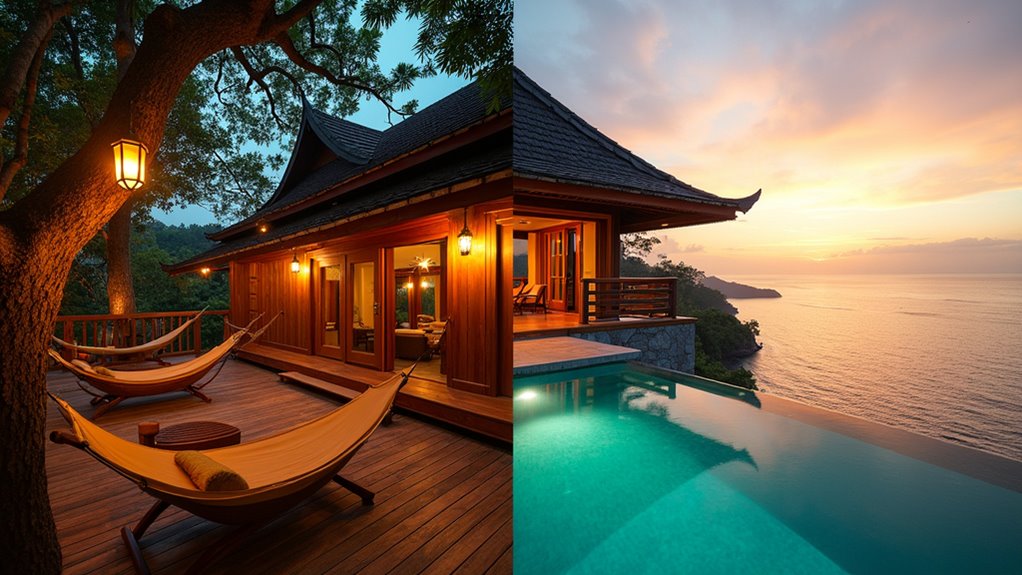
Where you lay your head at night considerably impacts your Thai adventure, with Chiang Mai and Phuket offering distinctly different accommodation landscapes at varying price points.
Chiang Mai delivers 17% savings overall, with dorm beds starting at ฿150-300 versus Phuket’s ฿250-500. The northern city excels in heritage properties like Rachamankha Hotel with traditional Lanna architecture, while digital nomads gravitate toward Nimmanhaemin’s apartments with dedicated workspaces.
Phuket counters with beachfront luxury, especially in Kamala and Surin areas where private pool villas come with concierge service. Travelers seeking unique seaside experiences can enjoy wellness retreats and various water sports activities along Phuket’s stunning coastline. For those considering island alternatives, Koh Lanta offers a more laid-back atmosphere compared to the popular Koh Samui.
For unique experiences, consider Chiang Mai’s rice field retreats in Mae Rim or Phuket’s converted Sino-Portuguese mansions in Phuket Town.
Budget travelers and long-term stayers will stretch their baht further in Chiang Mai, while Phuket justifies its premium with ocean views.
Transportation presents one of the most striking contrasts between Chiang Mai and Phuket, with each destination offering distinct experiences for traversing both locally and beyond.
In Chiang Mai, you’ll enjoy lower transportation costs and less congestion. The city’s extensive road network makes motorcycle rentals and public buses practical options for exploring.
Conversely, Phuket struggles with limited main roads leading to significant traffic jams, especially during peak season. Drivers in Phuket tend to be more aggressive and impatient compared to those in Chiang Mai.
For inter-city travel, direct flights connect both destinations in about 1.5 hours, while budget travelers might prefer the 24-hour Green Bus journey offering scenic countryside views.
No direct trains exist between these cities.
Chiang Mai generally provides better English support and more affordable tuk-tuks and taxis, while Phuket offers more developed tourist transportation infrastructure despite higher costs. Many visitors combine transportation needs with their training regimen, as Thailand offers some of the best Muay Thai gyms for foreigners seeking authentic martial arts experiences.
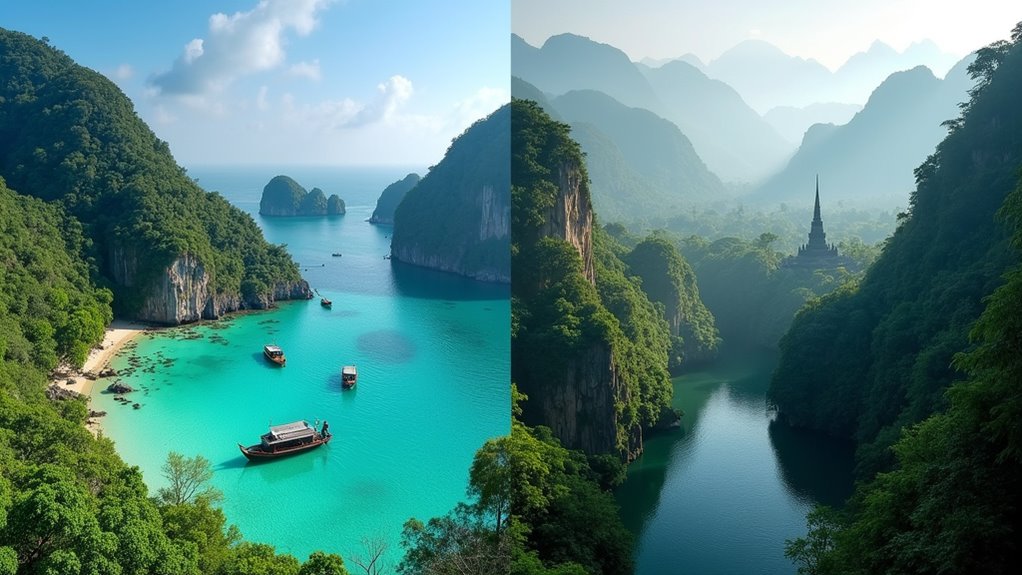
One of the most exciting aspects of visiting Thailand lies in your day trip options, which differ dramatically between Chiang Mai and Phuket. Phuket serves as your gateway to stunning islands like Phi Phi, Phang Nga Bay, and the Similan Islands, where turquoise waters and limestone formations create postcard-perfect scenery. While Phuket offers magnificent coastal experiences, it’s worth noting that nearby Koh Phangan island provides a more relaxed alternative with fewer crowds.
In contrast, Chiang Mai offers mountain adventures through:
Timing matters for both destinations. Visit Phuket’s islands during dry season (November-April) for beneficial conditions, while Chiang Mai’s mountains are best experienced during the cool season (November-February), avoiding the smoky burning season. Both destinations provide action-packed activities, with Chiang Mai focusing on cultural exploration and Phuket emphasizing water-based adventures.
When considering Thailand’s two most popular tourist destinations, the contrast between crowds and authentic experiences becomes starkly apparent.
Phuket’s mass tourism model draws enormous crowds, with occupancy rates reaching 75.77% and generating nearly five times Chiang Mai’s revenue. Its 340 daily flights (up 7.59%) reflect this volume.
Chiang Mai offers a more balanced approach with moderate occupancy rates and community-driven tourism through night bazaars and homestays. The city features 117 temples that showcase the rich cultural heritage of Northern Thailand.
While flight capacity has increased 17.65%, the cultural focus remains on temples, Lanna heritage, and local markets.
For authenticity, visit during shoulder seasons: May-October for Phuket and June-October for Chiang Mai.
Alternatively, time your trip around cultural events like Yi Peng in Chiang Mai for deeper immersion than Phuket’s commercialized offerings.
Those seeking less crowded island experiences might consider Koh Chang as a quieter alternative to Phuket while still enjoying Thailand’s renowned coastal beauty.
You’ve likely heard that you must choose between Chiang Mai’s culture or Phuket’s beaches, but this oversimplifies Thailand’s two extremes. In reality, both destinations offer multifaceted experiences that cater to different priorities. Your ideal choice depends on your budget, preferred climate, culinary interests, work needs, and adventure style. Consider what matters most to you, and you’ll find your perfect Thai home base.